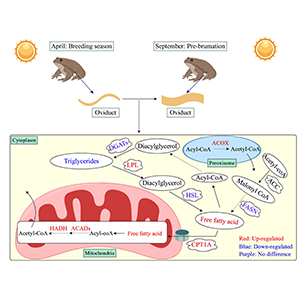Investigation of seasonal changes in lipid synthesis and metabolism-related genes in the oviduct of Chinese brown frog (Rana dybowskii)

All claims expressed in this article are solely those of the authors and do not necessarily represent those of their affiliated organizations, or those of the publisher, the editors and the reviewers. Any product that may be evaluated in this article or claim that may be made by its manufacturer is not guaranteed or endorsed by the publisher.
Authors
A peculiar physiological characteristic of the Chinese brown frog (Rana dybowskii) is that its oviduct dilates during pre-brumation rather than during the breeding season. This research aimed to examine the expression of genes connected with lipid synthesis and metabolism in the oviduct of R. dybowskii during both the breeding season and pre-brumation. We observed significant changes in the weight and size of the oviduct between the breeding season and pre-brumation. Furthermore, compared to the breeding season, pre-brumation exhibited significantly lower triglyceride content and a marked increase in free fatty acid content. Immunohistochemical results revealed the spatial distribution of triglyceride synthase (Dgat1), triglyceride hydrolase (Lpl and Hsl), fatty acid synthase (Fasn), and fatty acid oxidases (Cpt1a, Acadl, and Hadh) in oviductal glandular cells and epithelial cells during both the breeding season and pre-brumation. While the mRNA levels of triglycerides and free fatty acid synthesis genes (dgat1 and fasn) did not show a significant difference between the breeding season and pre-brumation, the mRNA levels of genes involved in triglycerides and free fatty acid metabolism (lpl, cpt1a, acadl, acox and hadh) were considerably higher during pre-brumation. Furthermore, the R. dybowskii oviduct's transcriptomic and metabolomic data confirmed differential expression of genes and metabolites enriched in lipid metabolism signaling pathways during both the breeding season and pre-brumation. Overall, these results suggest that alterations in lipid synthesis and metabolism during pre-brumation may potentially influence the expanding size of the oviduct, contributing to the successful overwintering of R. dybowskii.
Edited by
All animal testing procedures were approved by the Animal Protection and Utilization Policy of the Beijing Forestry University Ethics CommitteeSupporting Agencies
Beijing Natural Science Foundation, National Natural Science Foundation of ChinaHow to Cite

This work is licensed under a Creative Commons Attribution-NonCommercial 4.0 International License.
PAGEPress has chosen to apply the Creative Commons Attribution NonCommercial 4.0 International License (CC BY-NC 4.0) to all manuscripts to be published.













